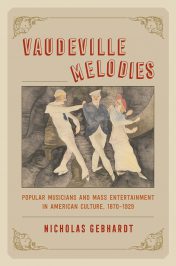While in the last part of the 19th century so-called “high art,” opera, theater, classical music and the like were deemed “too good” for the average working audience, these forms of entertainment ended up being controlled by the elite in the US. Controlled namely by those who wanted to solidify their own standing by attending such entertainment and supporting it financially.
 The “other” major form of entertainment, the popular one for the simple workers and middle-class Americans, happened in vaudeville (roughly from the 1880s to 1920s). The changing musical practices, repertoires and institutions were maybe the most important alterations that fostered the rise of American vaudeville in the late 19th century.
The “other” major form of entertainment, the popular one for the simple workers and middle-class Americans, happened in vaudeville (roughly from the 1880s to 1920s). The changing musical practices, repertoires and institutions were maybe the most important alterations that fostered the rise of American vaudeville in the late 19th century.
Owing much to the success and popularity of minstrel shows, many standard forms of performance, marketing, and stage entertainment are still in use even today in the globalized entertainment industry.
While the variety of acts there (singers, instrumentalists, animal acts, comedy, sportsmen, jugglers, impersonators, etc.) in a way were symbolic of the variety of the American public and their tastes, vaudeville was a medium that appealed to Americans and the new immigrants in the late 19th century alike. Most of all, as author Gebhardt tries to show, “… vaudeville has something important to tell us about the value of entertainment for Americans.”
While his focus actually is on the individual experience of the performers and how they organized their work and personae when they communicated in music and how artists once saw themselves connected to their audiences; an audience, that in return would show agreement or protest by different sorts of applause and even would get up during the show to voice criticism.
Vaudeville, this many-faced entertainment mix from theater, musical revue, talent show, carnival, and singing acts with the advent of radio, cinema and sound film, especially, disappeared. The specific definitions of entertainment, or what was considered activities that gave the workers an opportunity to leave the never-ending change of rest-work-rest briefly, going to a vaudeville show may have meant a very different form of entertainment where the audience and entertainers were placed in the same room, and generally had to share the same basic understanding of the world. Then, with the invention and availability of cheap movies instead of shows, both the audience and the sort of entertainment transformed into merely passive acts.
Another very important change took place when formerly individual performers and artists suddenly were marketed and (to a large part) owned by modern corporations. Gebhardt points out that these changes in the structure of business institutions “…also saw the emergence of a new business class: a powerful group of managers, experts and professionals who increasingly controlled these institutions and played a central role in making these transformations possible. … Vaudeville was inseparable from this process. This accounts not only for the importance of the transcontinental syndicates … But, equally, it underlines the significance of the larger movement toward corporate control in all aspects of show business, from the centralization of the booking process to song production, from the corporate reform of management to the mass circulation of trade newspapers such as Billboard and Variety.”
Gebhardt works with many biographies and quotes first hand reports when he wants to present the important role of vaudeville as a means to communicate, and most of all discusses different cultural forms of expression from various origins, be they simple and rural, located in the working class, or halfway elitist as acts of classical singers and trained orchestra musicians.
“For audiences, too, the experience [of vaudeville] was multilayered. Familiarity and repetition among small-time routines were just as valued as the novelty, surprise, and invention associated with high-class acts. … It was a space within which performers and audiences and managers continually negotiated between, and respond to, their different understandings of the cultural value and meaning of diverse musical styles and practices …. While powerful distinctions were clearly at work within the course of a show, from the persistence of blackface minstrel acts to the presence of what were described as high-class turns, equally, these same acts were continually revised, or sometimes revived, in response to the changing sensibilities of audiences.”
While the book is well-researched and detailed as the author follows his theory of major changes in the management of vaudeville acts, in the final chapter, he suggests a rather adventurous approach to the history of “the blues,” namely that this music was promoted mostly by vaudeville shows.
Taking as main example several biographies of one single artist: Bessie Smith (which is hardly a solid basis for a new approach to blues history). Unfortunately, “the blues” are not described in detail, so it is not clear if this theory refers to country blues, maybe Delta blues or city blues. This leaves out a huge field of biographies, and memoirs of traveling black workers/musicians who spread songs and techniques on their journeys traveling solo, without the vaudeville. The same approach – giving vaudeville major credit for its distribution – is suggested by Gebhardt when it comes to early jazz, which is equally obscure (again, the basis here is one lone act, the Creole Jazz Band). However, this theory only emerges at the end of the book so it could be read as an idea for further research.
All in all, Vaudeville Melodies is a good study that should appeal to a variety of scholars and students from the fields of Music Management, American Studies, Cultural Studies, Media Studies and popular culture.
Review by Dr. A. Ebert © 2017
Nicholas Gebhardt. Vaudeville Melodies: Popular Musicians and Mass Entertainment in American Culture, 1870-1929. University of Chicago Press, 2017, 208 p.
